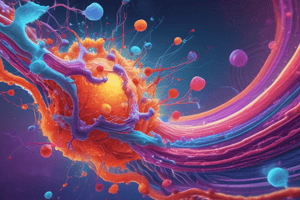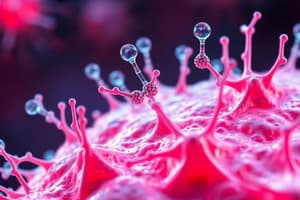Podcast
Questions and Answers
Interactions between messenger molecules and receptors can be affected by:
Interactions between messenger molecules and receptors can be affected by:
- Environmental factors
- Only receptor concentrations
- All of the choices can affect the interactions (correct)
- Only specific molecules
The cellular receptors for thyroid hormone are __________.
The cellular receptors for thyroid hormone are __________.
intracellular
Name the receptor that fits this description: A messenger molecule binds a membrane receptor activating a series of intracellular proteins which then acts on an additional protein in the cell membrane causing either a channel to open or an enzyme to be activated.
Name the receptor that fits this description: A messenger molecule binds a membrane receptor activating a series of intracellular proteins which then acts on an additional protein in the cell membrane causing either a channel to open or an enzyme to be activated.
G protein-coupled receptor
Name the receptor that fits this description: The receptor acts as both a receptor and an intracellular enzyme.
Name the receptor that fits this description: The receptor acts as both a receptor and an intracellular enzyme.
Name the receptor that fits this description: The receptor acts as a channel that often transports ions across cell membranes.
Name the receptor that fits this description: The receptor acts as a channel that often transports ions across cell membranes.
____________ is a signal molecule that is produced by endothelial cells to relax and dilate blood vessels as well as act as a neurocrine molecule in the brain.
____________ is a signal molecule that is produced by endothelial cells to relax and dilate blood vessels as well as act as a neurocrine molecule in the brain.
In an intracellular mediated response, the messenger is impermeable to the cell membrane.
In an intracellular mediated response, the messenger is impermeable to the cell membrane.
Membrane-bound receptors bind ligands that are __________.
Membrane-bound receptors bind ligands that are __________.
The process of a chemical messenger producing a response in the target cell is known as _____________________.
The process of a chemical messenger producing a response in the target cell is known as _____________________.
______________ are commonly directly involved in ion movement across cell membranes.
______________ are commonly directly involved in ion movement across cell membranes.
Hyposecretion is when an abnormally high level of hormone is released.
Hyposecretion is when an abnormally high level of hormone is released.
A deficiency of cholesterol would impact the synthesis of hormones that can freely cross the plasma membrane.
A deficiency of cholesterol would impact the synthesis of hormones that can freely cross the plasma membrane.
Hormones that enhance the responsiveness of a target organ to a second hormone have:
Hormones that enhance the responsiveness of a target organ to a second hormone have:
Thyroid hormones bind to receptors that are intracellular and regulate gene transcription.
Thyroid hormones bind to receptors that are intracellular and regulate gene transcription.
Most hormones are controlled by positive feedback mechanisms.
Most hormones are controlled by positive feedback mechanisms.
The following are tropic hormones EXCEPT:
The following are tropic hormones EXCEPT:
What ensures that blood levels of specific hypothalamic hormones are locally high in order to stimulate the anterior pituitary?
What ensures that blood levels of specific hypothalamic hormones are locally high in order to stimulate the anterior pituitary?
A cell is only able to respond to hormones if specific hormone receptors are present on the membrane or within the cell.
A cell is only able to respond to hormones if specific hormone receptors are present on the membrane or within the cell.
Slow axonal transport moves soluble proteins back and forth from the axon terminals and the neuron cell body at a rate of about 20mm/day.
Slow axonal transport moves soluble proteins back and forth from the axon terminals and the neuron cell body at a rate of about 20mm/day.
Which type of cell lines the ventricles of the brain and help produce cerebrospinal fluid?
Which type of cell lines the ventricles of the brain and help produce cerebrospinal fluid?
The myelin sheaths of PNS neurons are produced by:
The myelin sheaths of PNS neurons are produced by:
Depolarization of an axon is a positive feedback mechanism because ________.
Depolarization of an axon is a positive feedback mechanism because ________.
The period of time when Na+ channels are recovering from their inactive state and K+ channels are still open is the ________.
The period of time when Na+ channels are recovering from their inactive state and K+ channels are still open is the ________.
The average resting membrane potential of an axon is ________.
The average resting membrane potential of an axon is ________.
During an action potential ________.
During an action potential ________.
Which ion's movement is responsible for repolarization?
Which ion's movement is responsible for repolarization?
How do neurons code for a greater response?
How do neurons code for a greater response?
What is needed to return a membrane to its resting membrane potential, with all ions in the correct locations?
What is needed to return a membrane to its resting membrane potential, with all ions in the correct locations?
The minimum depolarization needed to open Na+ gates and fire an action potential is called the ________.
The minimum depolarization needed to open Na+ gates and fire an action potential is called the ________.
Which of the following is true about voltage-gated potassium channels?
Which of the following is true about voltage-gated potassium channels?
Flashcards are hidden until you start studying
Study Notes
Receptor Interactions and Types
- Messenger interactions with receptors can be influenced by various factors, all of which may affect binding and activity.
- Thyroid hormone receptors are categorized as intracellular, functioning within cell membranes.
- G protein-coupled receptors activate a cascade of intracellular proteins, leading to ion channel opening or enzyme activation.
- Receptor-enzyme combination serves as both a receptor and an enzyme for signaling.
- Receptor-channels primarily transport ions across cell membranes, integral for cellular responses.
Signaling Molecules and Mechanisms
- Nitric oxide is produced by endothelial cells, responsible for blood vessel dilation and serving neurocrine functions in the brain.
- Signal transduction is the process through which a chemical messenger induces a cellular response.
- Membrane-bound receptors interact with lipophobic ligands, crucial for signal transmission.
Hormonal Regulation and Feedback
- Hormone hyposecretion refers to below-normal hormone levels, while hypersecretion denotes excessive release.
- Cholesterol is essential for synthesizing certain hormones that can freely cross cell membranes.
- Hormones can exhibit permissive effects, enhancing the response of target organs to subsequent hormones.
Neuronal Structure and Function
- Ependymal cells line brain ventricles and assist in producing cerebrospinal fluid (CSF).
- Schwann cells create myelin sheaths around peripheral nervous system (PNS) neurons, enhancing signal transmission.
- Depolarization in axons is driven by sodium influx, which can open more sodium channels, demonstrating a positive feedback loop.
Electrical Properties of Neurons
- The average resting membrane potential of an axon is approximately -70 mV.
- Action potentials occur due to Na+ influx causing depolarization, while K+ movement is responsible for repolarization.
- The Na+/K+ pump is essential for restoring resting membrane potential by redistributing ions across the membrane.
Neuronal Response and Action Potentials
- Increased frequency of stimuli is a method neurons use to encode a stronger response.
- The threshold represents the minimum depolarization necessary to activate sodium gates and initiate an action potential.
- Voltage-gated potassium channels open in response to action potential threshold, allowing K+ to exit the cell, contributing to repolarization and feedback regulation.
Studying That Suits You
Use AI to generate personalized quizzes and flashcards to suit your learning preferences.




